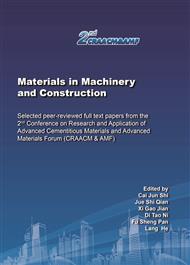[1]
F. Li, Y. Yuan, C. Li. Corrosion propagation of prestressing steel strands in concrete subject to chloride attack[J]. Construction Building Materials, 25(2011)3878-3885.
DOI: 10.1016/j.conbuildmat.2011.04.011
Google Scholar
[2]
Y. Li, X. Chen, L. Jin, et al. Experimental and numerical study on chloride transmission in cracked concrete[J]. Construction Building Materials, 127(2016)425-435.
DOI: 10.1016/j.conbuildmat.2016.10.044
Google Scholar
[3]
A. Delagrave, J. Maechand, J.P. Olliver. Chloride binding capacity of various hydrated cement systems[J]. Advanced Cement-Based Materials, 6(1997)28-35.
DOI: 10.1016/s1065-7355(97)90003-1
Google Scholar
[4]
A. Terzis, S. Filippakis, H. Kuzel, et al. The crystal structure of Ca2Al(OH)6Cl•2H2O[J]. Zeitschrift Für Kristallographie, 181(1987)29-34.
DOI: 10.1524/zkri.1987.181.1-4.29
Google Scholar
[5]
M.A. Sanjuan. Effect of curing temperature on corrosion of steel bars embed in calcium aluminate mortars exposed to chloride solutions[J]. Corrosion Science, 41(1998)335-350.
DOI: 10.1016/s0010-938x(98)00075-4
Google Scholar
[6]
M.A. Sanjuan. Formation of chloroaluminates in calcium aluminate cements cured at high temperatures and exposed to chloride solutions[J]. Journal of Material Science, 32(1997)6207-6213.
Google Scholar
[7]
Y.Z. Zhang. Production and application of China's calcium aluminate cement [M]. China: China Building Materials Industry Press, 2014.(in Chinese).
Google Scholar
[8]
B. Reddy, G.K. Glass, P.J. Lim, et al. On the corrosion risk presented by chloride bound in concrete[J], Cement Concrete Composition, 24 (2002)1-5.
DOI: 10.1016/s0958-9465(01)00021-x
Google Scholar
[9]
G.K. Glass, N.R. Buenfeld. The influence of chloride binding on the chloride induced corrosion risk in reinforced concrete[J]. Corrosion Science, 42(2000)329-344.
DOI: 10.1016/s0010-938x(99)00083-9
Google Scholar
[10]
C.M. Hansson, Th. Frolund, J.B. Maekussen. The effect of chloride cation type on the corposion of steel in concrete by chloride salts[J]. Cement Concrete Research, 15(1985) 65-73.
DOI: 10.1016/0008-8846(85)90009-2
Google Scholar
[11]
F. Pruckner, O.E. Gjory. Effect of CaCl2 and NaCl additions on concrete corrosivity[J]. Cement and Concrete Research, 34 (2004)1209-1217.
DOI: 10.1016/j.cemconres.2003.12.015
Google Scholar
[12]
A.K. Suryavanshi, J.D. Scantlebury, S.B. Lyon. Mechanism of Friedel's salt formation in cements rich in tri–calcium aluminate[J]. Cement Concrete Research, 26(1996)717-727.
DOI: 10.1016/s0008-8846(96)85009-5
Google Scholar
[13]
S. Gofii, M.T. Gaztanaga, J.L. Sagrera, et al. The influence of NaCl on the reactivity of high alumina cement in water:Poresolution and solid phase characterization[J]. Journal of Materials Research, 9(1994)1533-1539.
DOI: 10.1557/jmr.1994.1533
Google Scholar
[14]
N. Ukrainczyk, N. Vrbos, J. Šipusic. Influence of metal chloride salts on calcium aluminate cement hydration[J]. Advances in Cement Research, 5(2012)249-262.
DOI: 10.1680/adcr.11.00012
Google Scholar
[15]
P. Lu. Silicate physicochemistry[M]. NanJing: East-South University Publishing House, 1991. (in Chinese).
Google Scholar
[16]
D. Damidot, A. Rettel, A. Campas. Action of admixtures on Fondu cement: Part 1. Lithium and sodium salts compared[J]. Advances in Cement Research, 8(1996)111-119.
DOI: 10.1680/adcr.1996.8.31.111
Google Scholar
[17]
D. Damidot, A. Rettel, D. Sorrentino, et al. Action of admixtures on fondu cement: II. Effect of lithium salts on the anomalous setting time observed for temperatures ranging from 18 to 35°C[J]. Advances in Cement Research, 9(1997)127-134.
DOI: 10.1680/adcr.1997.9.35.127
Google Scholar
[18]
S. Goni, C. Andrade, C.L. Page. Corrosion behavior of steel in high alumina cement mortar samples: Effect of chloride[J]. Cement and Concrete Research, 21(1991)635-646.
DOI: 10.1016/0008-8846(91)90114-w
Google Scholar
[19]
V.S. Ramachandran, R.M. Paroli, J.J. Beaudion, et al. Handbook of thermal analysis of construction materials[M]. New York: Andrew W, Noyes Publications, (2002).
Google Scholar
[20]
J. Liu, Y. Jiang, Z. He, et al. Study on the influence factors of chloride binding in sea sand concrete[J]. Materials Review, 27(2013)129-132. (in Chinese).
Google Scholar
[21]
M.V.A. Florea, H.J.H. Brouwers. Chloride binding related to hydration products: Part I: Ordinary Portland Cement[J].Cement and Concrete Research, 42(2012) 282-290.
DOI: 10.1016/j.cemconres.2011.09.016
Google Scholar


